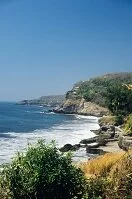Geography, Weather, & Wildlife of El Salvador
WARNING: Violence is common in El Salvador, please read this travel warning before going!
Geography

Coastline
El Salvador is located in Central America; to its northwest is Guatemala, while in its northeast stands Honduras. To El Salvador's west and south is the Pacific Ocean.
El Salvador is a small country, but is also very livable as the country has some flat stretches. There is a small plain along the Pacific Ocean, then there is a chain of volcanoes, followed by plains at elevation, and then a rise in elevation once more as you move east towards Honduras. Most of the people live in the country's central plateau, although people live throughout the country.
Weather
El Salvador offers differing temperatures by elevation, but these temperatures vary little by season. Along the Pacific Ocean temperatures tend to hover around 75-85° F (24-29° C) during the days, while on the plateau, where much of the population lives, daily averages are around 70-75° F (20-24° C). The mountains rarely get above 75° F (24° C) at any point of the year, but also rarely get to the freezing point, although nights tend to reach about 50° F (10° C). Despite fairly consistent temperatures year round, the weather in El Salvador changes with the rain and humidity. From about May to October the humidity is high and the rains fall as this is wet season, but again the plateau generally gets less rain than the mountains. Dry season runs from November to about April as the humidity generally falls significantly and rain is rare.